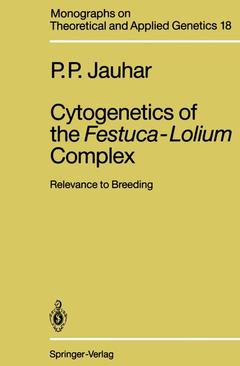Description
Cytogenetics of the Festuca-Lolium Complex, Softcover reprint of the original 1st ed. 1993
Relevance to Breeding
Monographs on Theoretical and Applied Genetics Series, Vol. 18
Author: Jauhar Prem P.
Language: English
Subject for Cytogenetics of the Festuca-Lolium Complex:
Publication date: 12-2011
255 p. · 15.5x23.5 cm · Paperback
255 p. · 15.5x23.5 cm · Paperback
Contents
/li>
1 The Festuca-Lolium Complex: a Fascinating Group of Grasses.- 1.1 Agronomic Importance.- 1.2 Distribution.- 1.3 Genetic Systems and Strategy for Germplasm Collection and Preservation.- 2 Taxonomic Treatments.- 2.1 General Considerations.- 2.2 Taxonomic Value of Epidermal Patterns and Leaf Sections.- 2.3 Limitations Imposed by Natural Introgression.- 2.4 The Lolium-Festuca-Vulpia Complex.- 2.5 Lolium L.- 2.6 Festuca L.- 2.7 Festuca arundinacea, a Compilospecies.- 2.8 Cytotaxonomic Affinities: Phylogenetic Considerations in the Festuca-Vulpia-Lolium Complex.- 3 Karyotypes and Species Evolution and Divergence.- 3.1 Karyotypic Features and Taxonomy.- 3.2 General Techniques of Studying Somatic Chromosomes.- 3.3 Chromosome Size Variation Among Diploids and Polyploids.- 3.4 Evolution by Increase in Chromosome Numbers.- 3.5 Evolution by Changes in DNA Content.- 3.6 DNA Content and Growth Habit.- 3.7 Constitutive Heterochromatin.- 3.8 Nucleolar Organizer Activity.- 4 Meiosis in Diploid and Polyploid Species.- 4.1 General Technique of Studying Meiosis.- 4.2 Meiosis in Diploids.- 4.3 Diploid-Like Meiosis in Polyploids.- 4.4 Breakdown of Diploidizing Mechanism in Haploid Complements in Hybrids.- 4.5 Chromosome Pairing in Polyhaploids.- 4.6 B Chromosomes in Relation to Diploidization of Tall Fescue.- 4.7 Different Diploidizing Mechanisms Compared and Contrasted.- 5 Reproductive Isolation Barriers Within the Tall Fescue Complex.- 5.1 Cytogenetic Basis of Reproductive Isolation.- 5.2 Various Other Meiotic Abnormalities in Hybrids Between Diverse Ecotypes.- 5.3 Occurrence of Univalents at Metaphase I: a Case of Desynapsis.- 5.4 Formation of Multivalents: Genetic Bases.- 5.5 Haplo-Insufficiency of the Pairing Control Genes?.- 5.6 Genetic Repression of Diploidizing Gene(s): an Example.- 6 Phylogenetic and Breeding Implications of the Genetic Control of Chromosome Pairing.- 6.1 Phylogenetic Relationships.- 6.2 Evolutionary Implications.- 6.3 Breeding Implications.- 7 B Chromosomes.-7.1 Occurrence and Adaptive Value.- 7.2 Pairing Among B Chromosomes in Hexaploid Tall Fescue.- 7.3 Effect on Genetic Recombination.- 7.4 Suppression of Homoeologous Pairing in Hybrids.- 7.5 B Chromosomes in Relation to Plant Breeding.- 8 Natural and Induced Polyploidy.- 8.1 Natural Polyploidy and Its Adaptive Value in Festuca.- 8.2 Absence of Natural Polyploidy in Lolium.- 8.3 Induced Polyploidy in Lolium.- 8.4 Distinguishing Features of Synthetic Polyploids of Lolium.- 8.5 Induced Polyploidy in Festuca.- 8.6 Occurrence of Aneuploids in Synthetic Polyploids.- 8.7 Polyploidy in Relation to Plant Breeding.- 9 Haploidy.- 9.1 Lolium Haploids.- 9.2 Festuca Haploids.- 10 Aneuploids.- 10.1 Lolium.- 10.2 Hexaploid Tall Fescue.- 11 Intra- and Inter-Specific Hybridization, Genome Relationships, and Plant Improvement.- 11.1 General Importance.- 11.2 Crossing Techniques.- 11.3 The Embryo Rescue Technique.- 11.4 Extensive Hybridization Work.- 11.5 General Meiotic Abnormalities in Wide Hybrids.- 11.6 Phylogenetic Proximity Among Species of the Lolium-Festuca Complex: a Generalized Picture.- 11.7 Intraspecific Hybrids in Lolium L.- 11.8 Intraspecific Hybrids in Festuca L..- 11.9 Interspecific Hybrids in Lolium.- 11.10 Hybrids Between the Two Ryegrasses: Development of Superior Germplasm.- 11.11 Interspecific Hybrids in Festuca.- 11.12 F. arundinacea (6x) x F. gigantea (6x) Hybridization: Development of Superior Germplasm.- 12 Intergeneric Hybridization, Genome Relationships, and Plant Improvement.- 12.1 Possible Affinity Between Festuca and Other Grass Genera.- 12.2 General Affinities Between Lolium and Festuca.- 12.3 Natural Hybrids.- 12.4 Synthetic Hybrids.- 12.5 Variation in Chromosome Size Between Diploid Species and Pairing in Their Hybrids.- 12.6 Intergeneric Hybridization and Production of Superior Breeding Material.- 13 Genomic Balance in Relation to Hybrid Fertility and Plant Improvement.- 13.1 Width of the Cross and Crossing Success.- 13.2 Choice of Parents.- 13.3 Choiceof Female Parent.- 13.4 Genomic Constitution and Hybrid Fertility.- 14 Biotechnology in Festuca-Lolium Improvement.- 14.1 General Scope and Importance: Genetic Engineering.- 14.2 Meristem-Tip Culture: a Method to Eliminate Pathogens.- 14.3 In Vitro Callus Cultures and Screening for Tall Fescue Endophyte.- 14.4 Organogenesis and Embryogenesis.- 14.5 In Vitro Cultures and Plant Regeneration.- 14.6 Anther Culture.- 14.7 Somaclonal and Gametoclonal Variation.- 14.8 Colchicine-Induced Variation.- 14.9 Environmentally Induced Somatic Variation.- 14.10 Cytogenetic Manipulation of Hybrid Material.- 14.11 In Vitro Chromosome Doubling.- 14.12 Protoplast Cultures: Regeneration of Plants.- 14.13 Genetic Manipulation at the Cellular Level.- 15 Conclusions and Perspectives.- References.
© 2024 LAVOISIER S.A.S.
These books may interest you

Chromosome Structure and Aberrations 158.24 €

Chromosome Structure and Aberrations 158.24 €


